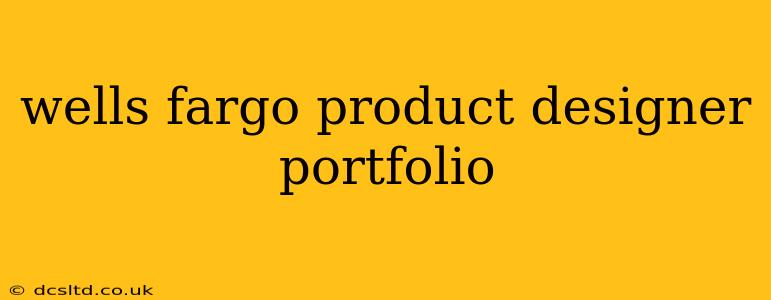Landing a role as a product designer at a prestigious financial institution like Wells Fargo requires a portfolio that showcases not only your design skills but also your understanding of the financial industry's unique challenges and opportunities. This isn't just about aesthetically pleasing visuals; it's about demonstrating a deep understanding of user needs, business goals, and the complexities of the financial landscape. This guide will walk you through the essential elements to include in your Wells Fargo-focused product design portfolio.
What Makes a Wells Fargo Product Designer Portfolio Stand Out?
Wells Fargo, like other major financial institutions, values designers who can demonstrate:
- User-centricity: Your portfolio should highlight projects where you've deeply considered the user experience, conducted thorough user research, and iterated based on user feedback. Show how you've solved real user problems through thoughtful design.
- Data-driven decision making: Showcase projects where you've used data and analytics to inform design choices and measure the success of your designs. Metrics like conversion rates, task completion rates, and user satisfaction scores are all relevant.
- Accessibility and inclusivity: Demonstrate your commitment to creating inclusive designs that are accessible to all users, regardless of their abilities. This includes considerations for users with visual, auditory, motor, and cognitive impairments.
- Understanding of financial products and services: While you don't need to be a financial expert, a basic understanding of financial products and services is crucial. Your portfolio should reflect this understanding through relevant case studies.
- Problem-solving skills: Highlight your ability to identify and solve complex design problems, especially within the context of financial services. Show how you've streamlined processes, improved usability, and increased efficiency.
- Visual Communication: Your portfolio's presentation should be as polished and professional as the designs themselves. Use high-quality images and clear, concise descriptions.
Essential Components of Your Portfolio
Here's a breakdown of the key sections your Wells Fargo product design portfolio should include:
1. Introduction: About You and Your Design Philosophy
Start with a brief introduction outlining your design experience, skills, and passion for designing user-friendly financial products. Highlight what makes you unique and why you're interested in working at Wells Fargo specifically.
2. Case Studies: Show, Don't Just Tell
This is the core of your portfolio. Each case study should follow a consistent structure:
- Project Overview: Briefly describe the project and its goals.
- Your Role: Clearly define your role and responsibilities in the project.
- The Problem: Articulate the user problem you addressed. Use data or user research to support your claims.
- Your Solution: Detail your design process, including your research methods, design decisions, and the iterations you made. Use visuals (wireframes, mockups, prototypes) to showcase your work.
- Results: Quantify the impact of your design. Did you improve user engagement? Increase conversion rates? Reduce support tickets?
- Lessons Learned: Reflect on your experience and what you learned from the project. This demonstrates self-awareness and a growth mindset.
3. Skills and Technologies
Create a section highlighting your key skills and the design tools and technologies you're proficient in (e.g., Figma, Sketch, Adobe XD, user research methodologies).
4. Contact Information
Make it easy for potential employers to contact you. Include your email address, LinkedIn profile URL, and portfolio website link (if applicable).
Frequently Asked Questions (PAAs): Addressing Potential Concerns
H2: What kind of projects should I include in my portfolio?
Focus on projects that demonstrate your ability to design user-friendly, accessible, and secure financial products. If you lack direct experience in financial services, highlight projects that demonstrate transferable skills, such as designing complex systems, simplifying processes, or creating intuitive interfaces for other industries.
H2: How many case studies should I include?
Aim for 3-5 strong case studies that showcase a range of your skills and experiences. Quality over quantity is key. Focus on depth rather than breadth.
H2: How can I make my portfolio stand out from other applicants?
Highlight your unique perspective and approach to design. Demonstrate a deep understanding of Wells Fargo's values and how your design philosophy aligns with them. Showcase your ability to adapt to different design challenges and demonstrate creativity and innovation.
H2: Is it important to showcase accessibility considerations in my portfolio?
Absolutely! Wells Fargo, like many companies, prioritizes accessibility. Demonstrating your understanding and implementation of accessibility guidelines (WCAG) is crucial.
By following these guidelines and crafting a well-structured, visually appealing, and data-driven portfolio, you'll significantly increase your chances of landing your dream role as a product designer at Wells Fargo. Remember, your portfolio is a reflection of your skills and your passion—make it count!
